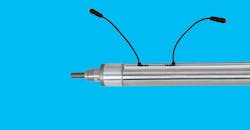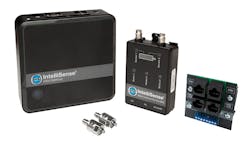5 Benefits of Using Electrical Switches
There’s nothing wrong with timers—if you have the time. But with manufacturing environments fully operational for 24 hours, 7 days a week, maintaining high production rates and efficiencies is critical.
Timers have been great performers in the past and they remain useful in the present. For example, there are accurate, cost-effective, multifunction, multirange industrial timers with as many as 10 unique operating modes within a single unit. There are timers that control the on/off cycle of equipment operations to enable hands-off customized procedures. There are programmable timers that can be set for any of five functions covering four different timing ranges. Timers always have had value, and advances in technology have increased their value.
But there’s one big thing timers don’t do. They cannot provide positive feedback (in the form of an electrical output signal) to the position of a device. Timers don’t give users circuit inputs to machine control logic which can optimize other areas of machine operation and add value to the machine control scheme.
That’s the job of—and the value in—electrical switches.
For example:
1. Switches Provide Real-Time Feedback on Machine Component Positions. Timers Don’t.
Switches are available in many styles including inductive proximity switches, mechanical limit switches, magnetic reed switches or solid state switches. And there are other kinds as well. All of these switches can be mounted on the driving device (the actuator) or on the driven device (such as a conveyor stop or gate). When activated, the switch will send a signal in the form of an electrical output. This output can then be used to turn on the PLC input, light a lamp or sound a horn. The output informs us that a specific machine operation and related parts have reached their intended destination.
Timers, in contrast, send an output when the timing cycle is completed. There is no direct link to the position of the machine component. In short, timers tell us “when.” Switches tell us “where” and “when.
2. Switch Output Signals Simplify Machine Setup
When switches are installed they can assist in determining the proper distance and relative location of machine components to make sure that they produce optimal parts. Furthermore, users can easily adjust switch positions even when the machine is being set up or running in its manual mode.
A project manager in Research and Development for a manufacturer of machine attachments employed in the commercial sewing industry, says, “High speed is an absolute requirement in our business. We can use timers for initial machine setup, but when it comes time to optimize our cycle rates, switches are an absolute requirement to replace the timers.
3. Machine Cycle Times Significantly Reduce When Switch Output Signals Initiate Machine Sequencing
Timers are generally less expensive than switches but in this particular area, that may be their only advantage. Timers can only determine an approximate time or “goal” for the completion of a given machine operation. If the driven device arrives before the previously inputted timing cycle has been completed, the machine will have to pause, resuming its operation only when the timer catches up. With switches, the programmer can recover the lost time by initiating the next machine movement as soon as the switch is activated.
4. Switch Output Signals Simplify Machine Troubleshooting
How much time slips away if there's a jam in a machine, a loss of pressure or a defective part? All you know at the outset is that your output has decreased. Then, you have to get it fixed.
With switches, used in conjunction with preprogrammed timers in machine control logic, you have a powerful troubleshooting tool. By programming an expected time to complete a cycle, the switch output signal can be used to confirm if the desired machine motion was completed in the allotted time. If the switch output is not received by the programmable controller when it should, you have proof that there has been a failure somewhere in the machine sequence. So, whether it’s some kind of bottleneck, leakage or something broken, using a switch with a timer shortens the troubleshooting time to identify the cause and location of the failure.
5. Switch Output Signals Provide Necessary Input to Safety Circuits
Switch output signals can provide the inputs required for programmable controllers to prompt safety circuits and protocols. Output signals can be programmed as logic elements to ensure that all parts of the machine are properly located for the safe shutdown and start-up of equipment. Make a mistake here and you can make an existing problem much worse.
The Next Logical Step: Predictive Maintenance
The next logical step in troubleshooting machine performance is a technology platform that enables users to be proactive about maintenance and system optimization. One such breakthrough is Bimba’s IntelliSense. It combines sensors, cylinders, and software to deliver real-time performance data. Tools such as this communicate real-time information to evaluate the potential life cycle of pneumatic components. Users receive operational insights about cylinder condition, cycle time, pressure, and temperatures down to a hundredth of a degree. In addition, they receive predictive intelligence in the form of up-to-date condition information that predicts when a cylinder will fail.
As we mentioned, electronic switches and timers are both important contributors to machine control. But machines that rely on timers to drive their sequencing can crash and/or extend valuable cycle times by forcing the machine to wait, even when a previous operation has been completed.
To determine which option or combinations make the most sense for your business, test your assumptions, your existing equipment, and your control schemes, and make sure you understand whether timers or switches will be most beneficial to the operation of your machine control circuits.
Bimba provides pneumatic, hydraulic, and electric motion solutions that are easy to use, reliable, and ready for all engineering solutions. Including its brands Acro, Electric, TRD, Vaccon, and the Pneumatic Controls Group (Mead/MFD/Pneumadyne). Bimba markets an extensive line of products including pneumatic, hydraulic, and electric actuators; valves; fittings; vacuum products; air preparation; and a variety of safety and production solutions. In addition to its broad line of standard catalog products, the company’s business develops many custom and semi-custom products designed for specific customers and applications. These products, used in machinery and automation are sold to OEMs and end-users throughout the world in an expanding variety of industries.

